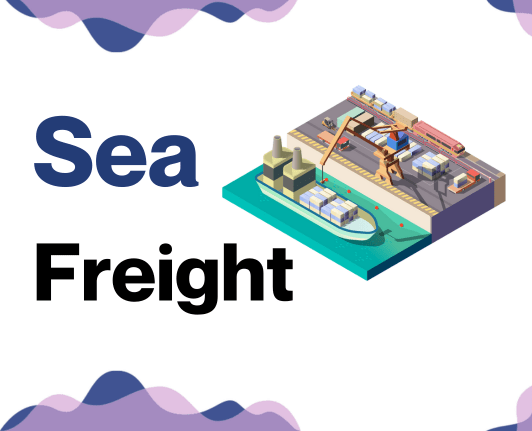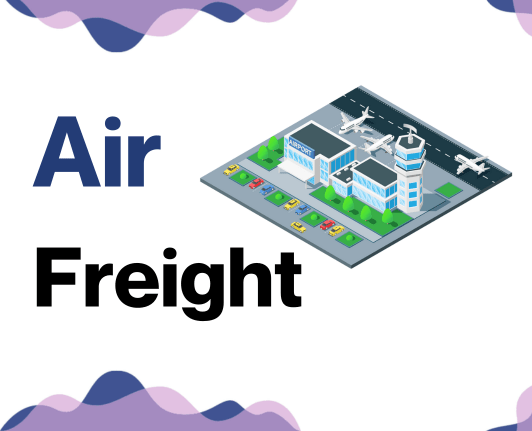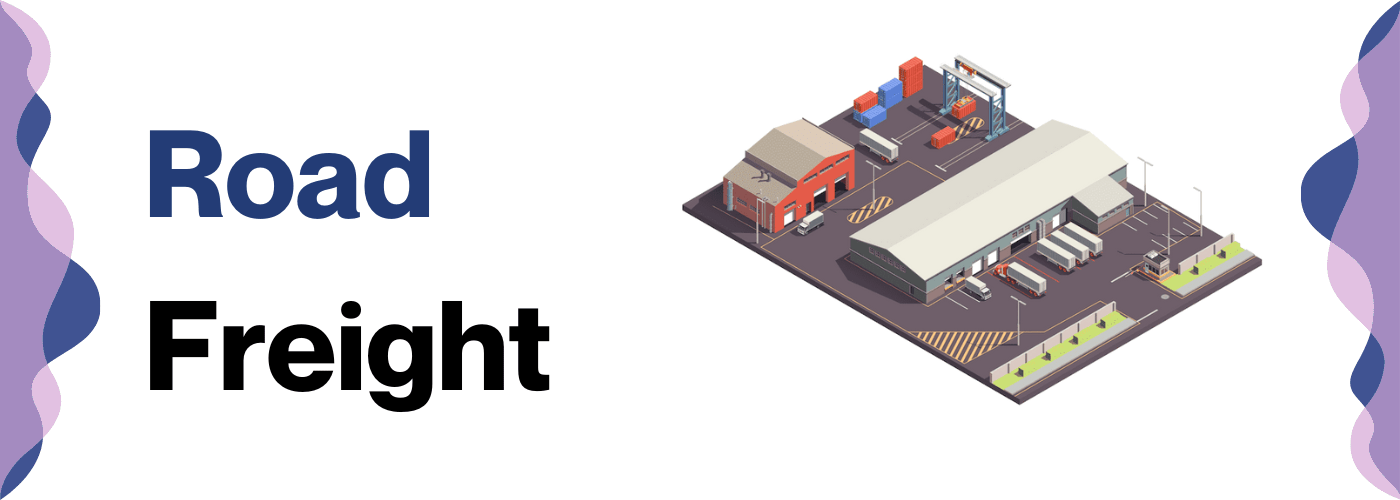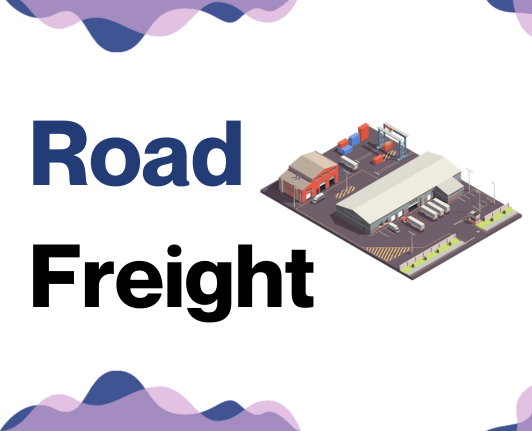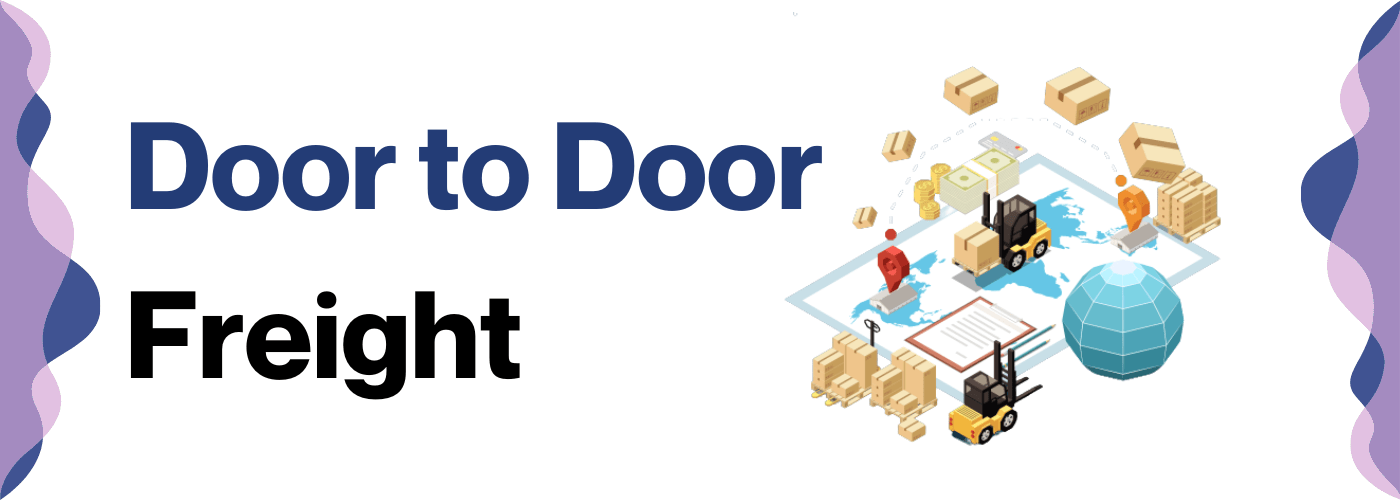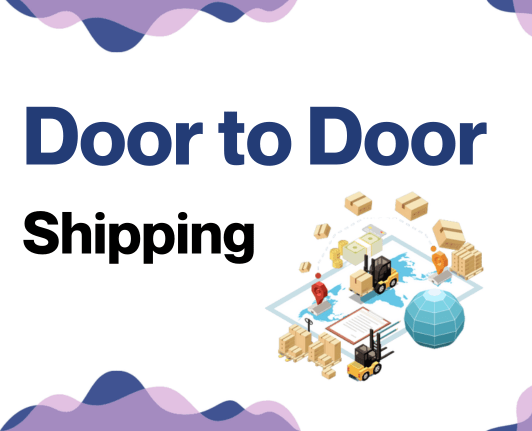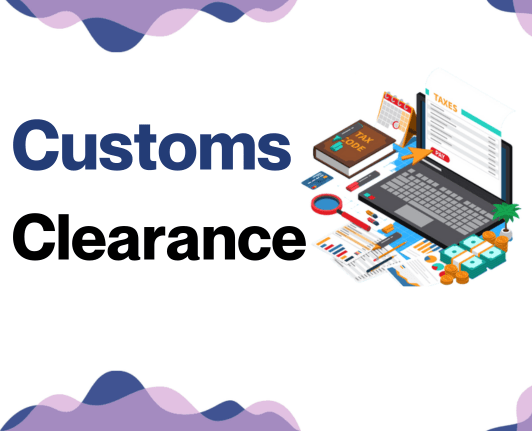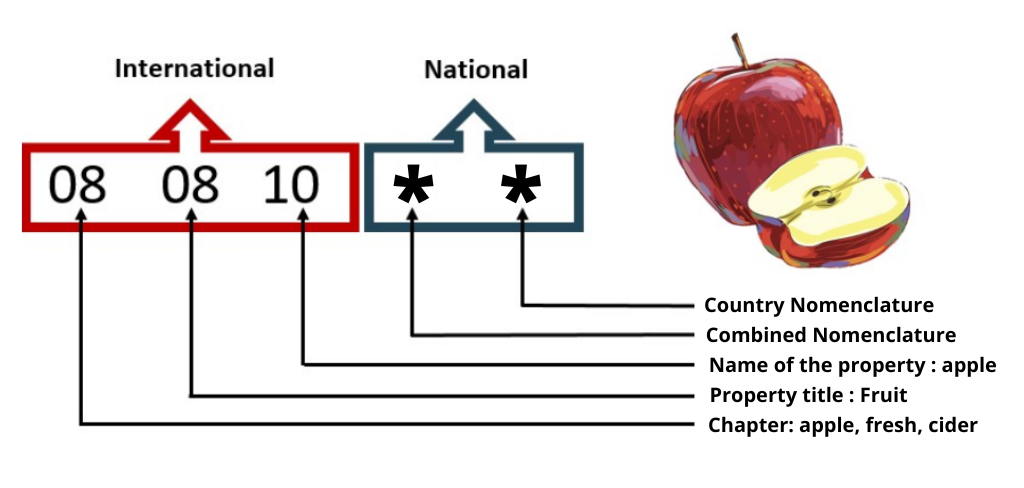Who thought freight shipping between the US and Canada could feel like braving a blizzard in Vancouver? Jokes aside, deciphering transit times, comprehending complicated rate structures, and familiarizing oneself with ever-changing customs regulations can be a daunting task for many businesses. This guide has been carefully curated to help you understand the various freight shipping options between our friendly neighbors, sea, air, rail, and road. We'll take a deep dive into the world of customs clearance, elucidate the nuances of duties and taxes, and provide targeted advice for businesses on both sides of the border. If the process still feels overwhelming, let DocShipper handle it for you! We are seasoned specialists in international freight forwarding, adept at transforming the Gordian knot of shipping challenges into smashing success stories for businesses of all sizes.
Table of Contents
ToggleWhich are the different modes of transportation between US and Canada?
Shipping goods from the US to Canada? It's a bit like planning a family road trip - there are different paths to the same destination. How quickly you need to arrive, what you're bringing, and your budget, all affect your route choice. Given the land connecting these two countries, road or rail transport often proves to be practical and cost-effective. However, if you're pressed for time or shipping high-value goods, air freight is your speedy express delivery. It's critical to pick the right transportation mode - akin to choosing the perfect vehicle for your road trip - it can make the journey smooth or bumpy.
How can DocShipper help?
Looking to ship goods between the US and Canada? DocShipper simplifies this complex task, taking care of every step to ensure smooth sailing. We handle transport organization, customs clearance, and administrative work. Have a question? Our consultants are always just a call away. Get your free estimate today, delivered to your inbox within 24 hours.
DocShipper Tip: Sea freight might be the best solution for you if:
- You are shipping large volumes or bulky items, as sea freight offers the most space at a cost-effective rate.
- Your cargo doesn't have an urgent deadline, as sea freight typically has longer transit times compared to air or rail.
- Your shipping routes are between major ports, allowing you to leverage the extensive global network of sea shipping lanes.
Sea freight between US and Canada
With the bustling trade relationship between the US and Canada, many businesses often find themselves shipping goods across the border. These operations mainly occur via several key ports, where vibrant cargo activities energize the industrial centers on both sides. Ocean freight proves popular due to its cost-effectiveness for high-volume goods, despite taking a longer time. However, it's not a walk in the park. Many shippers and businesses juggle numerous difficulties, making this process feel like solving a calculus problem.
Imagine reducing these complexities, like turning that calculus problem into simple arithmetic. By following best practices and guidelines, sea freight becomes much simpler. This guide aims to make your shipping process smooth, efficient, and error-free. Don't worry about the choppy waters, we're here to guide you through the sea of shipping between the US and Canada. And remember, the calm sea never made a skilled sailor. Stick around to arm yourself with the right knowledge, and turn your shipping woes into a breeze!
Main shipping ports in US
Port of Los Angeles
Location and Volume: Located in San Pedro Bay, the Port of Los Angeles is a crucial component for US-Asia trade, with a shipping volume of over 9.2 million TEU annually.
Key Trading Partners and Strategic Importance: Its key trading partners include China, Japan, South Korea, and Taiwan. This port holds strategic importance due to its size and leading-edge cargo handling technologies.
Context for Businesses: If you're targeting to expand or strengthen your trade connections in Asia, the Port of Los Angeles, with its vast network, will prove crucial to your logistics strategy.
Port of Long Beach
Location and Volume: Situated adjacent to the Port of Los Angeles, the Port of Long Beach handles a shipping volume close to around 8 million TEU.
Key Trading Partners and Strategic Importance: Its core trading partners are China, South Korea, and Japan. The port is strategic for businesses due to its advanced green port policy, indicating commitment towards sustainable business practices.
Context for Businesses: If your business is looking to adopt green shipping practices, you might want to consider using the Port of Long Beach with its award-winning commitment to environmental sustainability.
Port of New York and New Jersey
Location and Volume: Located on the East Coast, this port annually deals with approximately 7.5 million TEU.
Key Trading Partners and Strategic Importance: Key trading partners include China, Germany, and India. It's the busiest port on the East Coast, making it strategically essential for dealing with Europe and Asia.
Context for Businesses: If your business is closely aligned with European or Indian markets, then the Port of New York and New Jersey could be an essential part of your shipping strategy, given its strategic location and versatile capabilities.
Port of Savannah
Location and Volume: Situated in Georgia, the Port of Savannah has an annual handling volume of around 4.6 million TEU.
Key Trading Partners and Strategic Importance: Main trading partners are China, Germany, and South Korea. Its strategic importance lies in its ability to handle large vessels and efficient terminal operations.
Context for Businesses: If you require cost-effective shipping solutions while storing your goods, the Port of Savannah, with its abundant warehousing space, could aid you in your shipping strategy.
Port of Seattle
Location and Volume: Positioned in the Pacific Northwest, the Port of Seattle records an annual shipping volume of around 3.5 million TEU.
Key Trading Partners and Strategic Importance: It facilitates trade mainly with China, Japan, South Korea, and Vietnam. It's strategically essential due to its extensive connectivity to the Midwest through rail networks.
Context for Businesses: If your market spans across the Pacific Rim or Midwest, the Port of Seattle's well-structured rail connectivity might fit well into your logistics plans.
Port of Virginia
Location and Volume: Located on the US East Coast, this port handles around 2.9 million TEU annually.
Key Trading Partners and Strategic Importance: China, Germany, and Brazil are key trading partners. This port holds strategic importance due to its deep channels and large shipping facilities.
Context for Businesses: If your business involves large vessels, or you need access to the Midwest, the Port of Virginia, with its exceptional infrastructure and direct inland connections, could significantly bolster your logistics strategy.
Main shipping ports in Canada
Port of Vancouver
Location and Volume: Situated in Vancouver, British Columbia, the Port of Vancouver boasts being Canada's largest and most diversified port. As a major hub of trans-Pacific trade, simultaneous with a cargo volume of over 144 million tons annually, it is an essential element in the global commerce scene.
Key Trading Partners and Strategic Importance: Principally trading with Asia, Europe, and the United States, the port embodies a vital economic powerhouse for Canada. Its strategic location offers direct access to the North American Intercontinental railway, making it significant for consolidating multi-modal freight hauls.
Context for Businesses: If your business is intent on leveraging efficient, coast-to-coast access to the North American market, Vancouver's port is potentially a valuable cornerstone of your shipping strategy with its seamless rail, road, and ocean connectivity.
Port of Montreal
Location and Volume: Positioned on the St. Lawrence River, the Port of Montreal is an important gateway for cross-Atlantic trade, offering direct access to North American markets. With an annual shipment volume of over 38 million tonnes, it's a significant hub for maritime cargo transportation.
Key Trading Partners and Strategic Importance: Primarily hitched to transatlantic trade lanes, it registers robust trade relations with Europe, the Mediterranean, and the Middle East. Its 'continuous berth' feature, enabling several vessels to load and unload simultaneously, stands out.
Context for Businesses: If you're planning to tap into the European market or handle larger volumes of container cargo, integrating the Port of Montreal into your logistics could streamline your operations, given its unique continuous berth advantage and direct rail and highway links to major Canadian and US cities.
Port of Prince Rupert
Location and Volume: Nestled in Prince Rupert, British Columbia, the Port of Prince Rupert is the closest North American port to Asia by up to 58 hours, with an annual cargo volume of over 26 million tons.
Key Trading Partners and Strategic Importance: Predominantly linked with markets in Asia and the US Midwest, the port prides itself on its lean supply chain and prompt cargo transit times, giving businesses unparalleled speed and reliability.
Context for Businesses: If your objective is to expedite shipping times to and from Asia while maintaining connectivity with the US Midwest, the Port of Prince Rupert might be just the asset you need. Its efficient supply chain and fast transit times can provide your business with a significant competitive edge.
Location and Volume: Located in Nova Scotia, the Port of Halifax is the largest east coast port in Canada. Its deep, ice-free harbour has annual cargo volumes of over 4 million tons.
Key Trading Partners and Strategic Importance: Mainly trading with Europe, Asia, the Middle East and other parts of North America, Halifax Port is the only port on the east coast of Canada that can receive Ultra class vessels, providing major strategic importance.
Context for Businesses: If your business ships large quantities of goods, particularly on Ultra class vessels, the Halifax Port could be a key part of your logistics strategy, given its capacity to handle such vessels and its excellent global connectivity.
Port of Quebec
Location and Volume: The Port of Quebec resides at the heart of the North-South trade corridor, with an annual cargo handling of nearly 28 million tons.
Key Trading Partners and Strategic Importance: Its trading partners range across the globe, but with a particular emphasis on the Americas, Europe, and Asia. Befitted with multi-purpose and bulk handling facilities, it signifies a pivotal node for granular and liquid bulk shipping.
Context for Businesses: If your business deals primarily in bulk commodities and strives for cost-effective ways to access both the North American markets and the maritime route of the St. Lawrence seaway, Quebec's port could be advantageous, given its sophisticated bulk handling amenities.
Port of Hamilton
Location and Volume: Located on the western tip of Lake Ontario, the Port of Hamilton is the busiest Canadian Great Lakes port, moving more than 10 million tons of cargo annually.
Key Trading Partners and Strategic Importance: Catering chiefly to the US, Europe, and North Africa, it's strategically positioned as a feeder port while providing access to the densely populated Southern Ontario region.
Context for Businesses: If you aim to better serve the Southern Ontario market or seek a harmonized shipping hub for smaller, more frequent shipments, the Port of Hamilton could be a suitable choice given its extensive feeder network and strategic regional proximity.
Should I choose FCL or LCL when shipping between US and Canada?
Embarking on the sea freight journey between the US and Canada? Opting for the right shipping method, be it Full Container Load (FCL) or Less than Container Load (LCL), commonly known as consolidation, can steer your business towards significant cost savings and timely deliveries. Grasping the nuances of these choices isn't just about understanding logistics jargon - it's a strategic move that can shape your shipping success. Let's dive into the pros and cons of each, helping you chart a course tailored specifically to your shipping needs.
LCL: Less than Container Load
Definition: LCL (Less than Container Load) shipping denotes the transportation method where your goods don't fill up an entire container and share space with cargo from other shippers.
When to Use: LCL makes sense for low-volume shipments where the cargo is between the range of 13 to 15 CBM (Cubic Meters). The flexibility and price efficiency of this option makes it preferred for businesses not requiring the full capacity of usual 20ft or 40ft containers.
Example: For instance, a furniture business in Seattle that needs to send a small batch of chairs to a retailer in Toronto may opt for LCL shipment over a full container load. Here, they avoid paying for unused space yet ensure a safe and timely delivery.
Cost Implications: Pricing for LCL freight includes charges based on volume, leading to cost efficiencies for fewer goods. However, remember that sharing a container might increase handling fees due to multiple shipments' various processes operating within one container. To overcome this, get an inclusive LCL shipping quote that clarifies all costs upfront.
FCL: Full Container Load
Definition: FCL (Full Container Load) shipping is when a single exporter books a whole container, either a 20’ft or 40’ft, to transport goods.
When to Use: FCL is particularly beneficial when your cargo measures more than 13/14/15 CBM, meaning you harness the container's total space. It offers cost-effectiveness for high volume shipments due to the flat rate per container. Additionally, since the container is sealed from origin to destination, it ensures enhanced safety for your goods.
Example: Consider a manufacturing firm exporting machinery parts from Dallas to Toronto. Their cargo occupies a whole 40'ft container. Choosing FCL they guarantee the security of their goods and potentially save costs versus multiple LCL (Less than Container Load) shipments.
Cost Implications: While FCL might initially seem expensive, it becomes cheaper per CBM (cubic meter) as the volume of your shipment increases. For an exact cost breakdown, approach a freight forwarder or shipping line for an FCL shipping quote. Remember, the rate could vary based on the route, the season, and the container size.
Unlock hassle-free shipping
Experience the ease of shipping with DocShipper, your dedicated freight forwarder making cargo transfers between the US and Canada hassle-free. Our ocean freight specialists help you decide between consolidation and full container options, examining essential aspects like your budget, volume, and urgency. Trust in our expertise to find an optimized shipping solution tailored for your business needs. Ready to set sail? Contact us and get your free estimation today!
How long does sea freight take between US and Canada?
The journey across the border by sea freight from the US to Canada typically takes average timeframes. However, transit times can vary based on several factors. Specific ports used, the weight of the goods, and their nature play substantial roles in determining the timeframe. To get an estimate tailored to fit your specific shipping needs, get a quote from a competent freight forwarder such as DocShipper.
The table below exhibits average transit times, illustrated in days, for sea freight between the major freight ports in the US and Canada. Please note, this data stands as an average estimate and may vary:
| US Port | Destination Port in Canada | Average Transit Time (Days) |
| Port of Los Angeles | Port of Vancouver | 11-30 |
| Port of Long Beach | Port of Montreal | 20-40 |
| Port of Savannah | Port of Prince Rupert | 15-25 |
| Port of Seattle | Port of Halifax | 14-45 |
*Calculations of transit times should always be considered as estimates and not precise figures, since they are subject to change due to unforeseen circumstances.
How much does it cost to ship a container between US and Canada?
Deciphering ocean freight rates between the US and Canada can feel much like solving a jigsaw puzzle due to several factors. Pinning down the exact shipping cost per Cubic Meter (CBM) is not straightforward as it relies heavily on the Point of Loading, Point of Destination, the selected carrier, the type of cargo, and even monthly market trends. But worry not, our adept shipping specialists will work tirelessly for you. Whether you're shipping intricate machinery or long-lasting textiles, we tailor our quotes to your unique needs to ensure the most competitive rates. Take the guesswork out of your next shipment with us, as we make international logistics as smooth as possible.
Special transportation services
Out of Gauge (OOG) Container
Definition: OOG containers or Out of Gauge containers refer to shipments that exceed standard shipping dimensions, making them unsuitable for traditional containers.
Suitable for: Oversized items, heavy weight cargo such as machinery, industrial equipment, and construction materials.
Examples: Large industrial components, mining equipment, wind turbines, etc.
Why it might be the best choice for you: The flexibility in size accommodates your non-standard items, making it ideal if you deal with unusually large or heavy products.
Break Bulk
Definition: Break bulk is the process of transporting cargo that does not fit onto flat racks or into containers, and cannot be handled in bulks. The goods are loaded individually, not in intermodal containers nor in bulk as with oil or grain.
Suitable for: Large items that are unmanageable for standard containers, including construction equipment, manufacturing materials, etc.
Examples: Large yachts, tanks, pre-fabricated components for construction.
Why it might be the best choice for you: Highly effective for large goods that can be divided into units, providing a blend of flexibility and security during sea fright.
Dry Bulk
Definition: Dry bulk refers to cargo that is shipped in large, unpackaged amounts. Covering a wide range of commodities like coal, cement, grains, metal ores or minerals. They are loaded directly into a ship's hold.
Suitable for: Commodities that can be poured or dumped straight into the ship's hold.
Examples: Sand, sugar, grains, coal, etc.
Why it might be the best choice for you: If your business deals with large amounts of loose cargo load, the scalability of dry bulk shipping may be perfect for you.
Roll-on/Roll-off (Ro-Ro)
Definition: Roll-on/Roll-off shipping involves vehicles or machinery that are driven on and off a specialized ro-ro vessel under their own power or with the aid of a platform vehicle.
Suitable for: Cars, trucks, tractors, trailers, buses, boats, heavy machinery and equipment.
Examples: New cars for dealerships, used equipment for auction, farm machinery etc.
Why it might be the best choice for you: If your inventory is self-propelling or on wheels, Ro-Ro offers a hassle-free and efficient handling process of your shipment.
Reefer Containers
Definition: Reefer containers are refrigerated containers used to transport temperature-sensitive goods. The temperature of these containers can be precisely controlled to preserve the quality of the goods.
Suitable for: Food and beverage products, pharmaceuticals, perishable items that require specific temperature controls.
Examples: Fresh fruits and vegetables, meat and seafood, vaccines, etc.
Why it might be the best choice for you: If your enterprise deals with perishable goods, these containers offer exceptional temperature control, maintaining the freshness and quality of your products.
Finding the right type of sea freight option can be a challenging task, but that's where we come in. DocShipper can ensure the optimal, cost-efficient and secure transportation of your goods between the US and Canada. For more personalized advice and a free shipping quote within 24h, feel free to reach out to us!
DocShipper Tip: Air freight might be the best solution for you if:
- You are in a hurry or have a strict deadline requirement, as air freight offers the fastest transit times.
- Your cargo is less than 2 CBM (Cubic Meter), making it more suitable for smaller shipments.
- Your shipment needs to reach a destination that is not easily accessible by sea or rail, allowing you to tap into the extensive network of global airports.
Air freight between US and Canada
When it comes to swiftly and efficiently sending small, valuables parcels from the US to Canada, air freight works like a charm, much like a sprinter delivering quick results. Imagine shipping high-tech gadgets or delicate glassware - air transport ensures speed, security, and reliability, attributes hard to match. Yet, many businesses stumble on the runway, catch their proverbial heels in pitfalls like misjudged pricing. Underestimating the weight of the cargo is a bit like forgetting to count the popcorn in the jar - both add up quickly. Blind spots in the procedures too can cost companies heftily, like a skipped step in an important recipe. Let's delve into how you can soar past these air freight missteps.
Air Cargo vs Express Air Freight: How should I ship?
If your business is seeking speedy delivery between the US and Canada, you'll come across two main options: Air cargo, which shares space in commercial airlines, or express air freight, where your goods enjoy the luxury of a dedicated plane. But how do you decide what's right for you? This piece will help you unravel the complexities and make the best shipping choice for your business needs. Stay tuned as we delve into this sometimes confusing realm of logistics.
Should I choose Air Cargo between US and Canada?
Air cargo between the US and Canada is a reliable and cost-effective shipping choice, particularly with goods exceeding 100/150 kg (220/330 lbs). Major airlines such as American Airlines and Air Canada offer extensive freight services with fixed schedules that ensure timely delivery, albeit with slightly longer transit times. Considering your budget and the weight of your cargo, this shipping solution could be a perfect fit. Remember, the reliability and cost-effectiveness of air cargo make it a standout choice for your business's freight needs.
Should I choose Express Air Freight between US and Canada?
Ideal for shipments under 1 CBM or 100/150 kg (220/330 lbs), express air freight is a top-tier service that employs specialized cargo planes, sans passengers, ensuring speedy delivery of your wares across borders. High-speed and secured, it can save time on crucial shipments. Companies like FedEx, UPS, and DHL are stalwarts in this field. So if fast, efficient delivery is your priority, this express freight option between the US and Canada may be the right choice for your business.
Main international airports in US
Los Angeles International Airport (LAX)
Cargo Volume: Handles over 2.2 million metric tons of cargo annually.
Key Trading Partners: Major partners include China, Japan, South Korea, Hong Kong, and Taiwan.
Strategic Importance: Strategically located on the U.S. West Coast, LAX plays a crucial role in Trans-Pacific trade.
Notable Features: LAX has expansive cargo facilities and is served by many freight airlines, contributing to its robust operations.
For Your Business: LAX's expansive routes, advanced facilities, and handling capacity make it ideal for businesses targeting Asian markets and beyond.
Chicago O’Hare International Airport (ORD)
Cargo Volume: Manages approximately 1.8 million metric tons of cargo annually.
Key Trading Partners: Main trading partners are Germany, Canada, China, South Korea, and Japan.
Strategic Importance: As a centrally located hub, O’Hare is pivotal in enabling efficient transit to both coasts of America and beyond.
Notable Features: Boasts state-of-the-art cargo facilities covering 2 million sq. ft., providing excellent services for cargo operations.
For Your Business: If a robust U.S. distribution network with strong ties to European destinations underpins your strategy, ORD is a preferred choice.
John F. Kennedy International Airport (JFK)
Cargo Volume: Moves approximately 1.6 million metric tons of cargo annually.
Key Trading Partners: Its major trading partners are European countries, including the UK, Germany, and Switzerland.
Strategic Importance: JFK is a primary gateway to Europe and the rest of the Northeastern United States.
Notable Features: JFK's cargo area spans over 4 million sq. ft., one of the largest among U.S. airports.
For Your Business: JFK's vast connections to Europe and top-notch facilities make it invaluable for businesses trading with European markets.
Miami International Airport (MIA)
Cargo Volume: Annually handles more than 2.1 million metric tons of cargo.
Key Trading Partners: MIA primarily serves markets in Latin America and the Caribbean.
Strategic Importance: This airport is geographically advantageous for trade with Latin America, dubbed the “Gateway of the Americas.”
Notable Features: The only U.S. airport certified as a pharmaceutical freight hub by IATA – ideal for transporting sensitive goods.
For Your Business: If your business trades significantly with Latin America or deals in pharmaceutical products, MIA offers extensive networks and specialized services.
Ted Stevens Anchorage International Airport (ANC)
Cargo Volume: Handles around 2.5 million metric tons annually.
Key Trading Partners: Major trade routes include Asia, North America, and Europe.
Strategic Importance: Leveraging its unique location, ANC allows cargo carriers to take advantage of 'technical stops' to refuel and change crews, making long-haul trips more efficient.
Notable Features: One of the top five cargo airports globally due to its strategic location.
For Your Business: If your business regularly ships long-haul freight, particularly between Asia and North America, ANC can offer critical efficiency gains.
Main international airports in Canada
Toronto Pearson International Airport
Cargo Volume: Toronto Pearson handles over 50% of Canada's air cargo.
Key Trading Partners: United States, Mexico, Japan, China, and the United Kingdom.
Strategic Importance: Operating as a hub for Air Canada, it's strategically positioned in North America's logistic network.
Notable Features: Infrastructure facilities include dual runways, over 70 cargo airlines, and dedicated cargo terminals.
For Your Business: With expansive facilities and a dominant market share, Toronto Pearson could streamline your logistics to and from Canada's biggest metropolitan area.
Vancouver International Airport
Cargo Volume: Handles over 338,590 tonnes of cargo annually.
Key Trading Partners: China, the United States, Japan, South Korea, and Taiwan.
Strategic Importance: Serves as a significant hub for Asia-Pacific cargo.
Notable Features: An efficient customs process and modern cargo facilities including temperature-controlled facilities for perishables.
For Your Business: Vancouver International is an excellent choice for businesses trading with the Asia-Pacific region, especially for temperature-sensitive goods.
Mirabel International Airport
Cargo Volume: Manages over 15% of Canada's total air cargo.
Key Trading Partners: United States, Europe and Asia.
Strategic Importance: Located in Montreal, it features as a significant player in the country's French-speaking province of Quebec.
Notable Features: Specializes in all-cargo flights with a dedicated cargo village.
For Your Business: Mirabel International could be the key to efficient shipping in and out of French-speaking markets.
Cargo Volume: Handles over 147,000 tonnes of cargo each year.
Key Trading Partners: United States, Asia, and Europe.
Strategic Importance: A hub for WestJet, it supports the western territories of Canada.
Notable Features: Comprehensive cargo facilities including a dedicated Cargo Village with freight forwarders and cargo handlers.
For Your Business: If your business focuses on the western Canadian provinces or you're a partner of WestJet, Calgary Airport is the logical choice to optimize your logistics.
Halifax Stanfield International Airport
Cargo Volume: This airport manages approximately 34,000 metric tonnes of cargo annually.
Key Trading Partners: Europe, United States, and Asia.
Strategic Importance: Positioned on the east coast, Halifax plays a crucial role in Atlantic Canada's cargo operations.
Notable Features: A dedicated cargo terminal, handling facilities for live cargo, and support for chartered cargo flights.
For Your Business: If your business trades with European vendors, Halifax Stanfield will effectively shorten your supply chain due to its strategic location.
How long does air freight take between US and Canada?
Typically, air freight shipping between the US and Canada can take between 1-3 days. However, this timeline can depend on various factors like the particular airports involved, the weight of the shipment, and the nature of your goods. Such variables can either speed up or slow down the entire process, making each shipping journey unique. For more accurate and personalized time estimates, consult a freight forwarder such as DocShipper.
How much does it cost to ship a parcel between US and Canada with air freight?
Air freight cost from the US to Canada averages around $2.50-$4.00 per kg. However, this is a broad estimate, as myriad factors such as airport location, dimensions, weight, and the nature of the goods can significantly affect the final price. Rest assured, our experienced team analyzes each shipment individually to offer the best possible rates. Remember, our quotes aren't one-size-fits-all, they're tailored to your specific needs. Contact us today and receive a free quote in less than 24 hours.
What is the difference between volumetric and gross weight?
Gross weight is the total weight of a shipment, including the products, packaging, pallets, etc. Volumetric weight, on the other hand, is a calculated value based on the space your shipment takes up within the aircraft.
Calculating the gross weight in air freight shipping is straightforward. You simply weigh all your shipped items along with their packaging, including any pallets, in kilograms.
For instance, if your shipment along with the packaging weighs 100 kg, there's no conversion to pounds necessary as 100 kg is roughly equal to 220 lbs.
Volumetric weight, also called dimensional weight, works a bit differently. It's a calculation that air carriers use to account for the space a package occupies in relation to its actual weight. The calculation in air cargo services follows this formula:
Volumetric weight (kg) = Length(cm) x Width(cm) x Height(cm) / 6000
For example, if you're shipping a box that's 100 cm long, 100 cm wide, and 100 cm high, then the volumetric weight of your shipment would be roughly 167 kg, which converts to approximately 367 lbs.
In Express Air Freight services, the calculation is similar. However, instead of 6000, the divisor used is 5000:
Volumetric weight (kg) = Length(cm) x Width(cm) x Height(cm) / 5000
So, using the same box dimensions, Express Air Freight services would equate the volumetric weight to be 200 kg which translates to around 440 lbs.
When it comes to freight charges, keep in mind that carriers use these calculations to optimize their cargo capacity. They will charge based on either the actual weight (gross weight) or the dimensional weight (volumetric weight), whichever is greater. Therefore, understanding these weights is crucial to predict shipping costs and make economical decisions about packaging and product sizing.
DocShipper tip: Road freight might be the best solution for you if:
- You're looking for a cost-effective option for shorter routes. For relatively short distances, road freight can be more economical than air freight and faster than sea or rail.
- Your destination is within the same continent or a neighboring country. Road freight is often the most straightforward and quickest option for cross-border freight and shorter distances.
- Your shipment is of irregular size or shape. Trucks offer flexibility in terms of cargo types and sizes, making it easier to transport goods that might not fit into standard sea containers or air cargo spaces.
Trucking between US and Canada
Navigating the 5,525-mile-long border between the US and Canada? Buckle up! Cross-border trucking is a viable option that connects businesses in both nations with stellar efficiency and cost-effectiveness. While transit times vary due to routes and road conditions, trucking often scores high compared to other freight modes. Expect savings on your balance sheet and a smaller carbon footprint on the environment. Sure, there are a few bumps on this road – think unpredictable weather or traffic. But the unparalleled flexibility and the ease of tracking your cargo in real-time make this model an attractive proposition for your supply chain.
What if I can’t fill a truck between US and Canada?
Eager to crack the code on freight options between the US and Canada? FTL and LTL transportation could be your answer, especially if you seek flexibility and cost-effectiveness. This is the business-savvy deep dive that could just revolutionize your cross-border logistics strategy. Stick with us to explore the ins and outs!
LTL: Less than Truck Load
Less than Truckload (LTL) freight is a shipping method where your cargo doesn't fill an entire truck. It's ideal if you're moving smaller, less-than-full truckloads between the US and Canada, typically when your goods measure less than 13-16 CBM (cubic meters).
Imagine you're a furniture company transporting a small collection of designer chairs. The volumetric space of chairs wrapped and ready for transport might be around 10 CBM. This volume would make your shipment a good fit for LTL freight, as it is under the 13-16 CBM range.
When to favor LTL:
- You're shipping smaller quantities of goods
- Your freight is less than 13-16 CBM
- Frequent and regular shipments are needed
- Cost-effectiveness is a priority over speed
- Requirement of less space, reducing the environmental footprint
This smart shipping method allows you to share the transport costs with others, making LTL shipment not only space-saving, but also cost-effective.
FTL: Full Truck Load
Full Truck Load shipping, often referred to as FTL freight, is a method of transport where your goods occupy the whole cargo space of a truck. If you're shipping large quantities, usually more than 13-15 CBM - think of a small bedroom filled top to bottom with your cargo - it's a practical option.
Let's envision you're a furniture manufacturer in the U.S looking to transport fifty 0.3 CBM chairs across the border to Canada. It's efficient to book an entire truck for your FTL shipment, ensuring your goods reach the destination safely, swiftly, and without getting mixed up with other cargos.
Here are some instances when choosing FTL might be the best route for you:
- Your cargo is time-sensitive and needs faster transit
- The goods you're shipping are high-value and require additional security
- Your shipment is larger, crossing that 13-15 CBM threshold
- You need to ship a fragile or special handling cargo that can't be consolidated with others
Knowing which option to choose rests on understanding your specific shipping needs. Grok your business, your timeline, and your cargo to direct the right shipping tool at the right time.
What are the main routes between US and Canada?
With thousands of miles of border, there are several key transportation arteries between the US and Canada. The bustling Interstate 5 (I-5) that stretches from San Diego all the way to Canada’s British Columbia is a popular route. For the central regions, you can't miss the Interstate 75 (I-75), connecting Michigan to Ontario's heart. Over on the east coast, the Interstate 95 (I-95) forms a vital corridor, linking the vibrant cities of Maine and New Brunswick. Factor in seasonal weather conditions like heavy snowfall, which could impact your schedule. Plan your route wisely, considering these major highways and upcoming weather predictions.
What are the road transit times between US and Canada?
On average, road transport between the US and Canada can take about 2-7 days. However, please keep in mind that the precise duration is hard to pinpoint due to unpredictable factors such as traffic congestion, vehicle circulation schedules, and, in some instances, poor road quality—for example, in remote areas. Rest assured, these are basic estimates, and you may reach out to us for a more tailored, cross-border freight quote within 24 hours.
How much does trucking cost between US and Canada?
Ditch the notion of one-size-fits-all pricing for trucking goods from the US to Canada - it just doesn't roll that way! Costs wave hello and bye at too many variables - weight, type, distance, you name it. But wipe that worry off your brow. Our cracking team is all set to hustle, tailoring quotes to fit your unique shipping needs. Hop on board for some wallet-friendly rates!
DocShipper tip: Door to Door might be the best solution for you if:
- You value convenience and want a seamless shipping process, as door-to-door takes care of every step from pickup to delivery.
- You prefer a single point of contact, as door-to-door services typically provide a dedicated agent to handle all aspects of the shipment.
- You want to minimize the handling of your goods, reducing the risk of damage or loss, as door-to-door minimizes transitions between different modes of transport.
Door to door between US and Canada
Looking for a hassle-free way to ship goods from the US to Canada? Consider international Door-to-door shipping: a complete package that covers all logistics from the start to the finish line. It's convenient and streamlined, taking the stress out of customs and documentation. Peeling back the layers of this shipping method reveals multiple benefits. So, let's roll up our sleeves and dive right in!
Overview – Door to Door
Overwhelmed by the complexities of shipping between the US and Canada? Consider the stress-free solution: Door to Door shipping. This is your ticket to bypass the mountain of paperwork, unpredictable delays, and customs bother. Although it might cost more than other options, the peace of mind, convenience, and time saved make it a worthwhile investment. In fact, it's the most sought-after service for our clients at DocShipper. Embrace this straightforward shipping method and focus more on growing your business instead of logistics. Delve deeper to understand why it's the favored choice for many.
Why should I use a Door to Door service between US and Canada?
Whoever said logistics was a headache, didn't have a Door-to-Door service navigating the waters between the US and Canada! Here are five reasons why you might want to give it a shot:
1. Banish the Stress of Logistics: From pick-up to delivery, everything is taken care of. Imagine sitting back with a cup of coffee, watching your goods journey across borders, without even lifting a finger.
2. Tick-Tock, Meet Your Clock: Urgent shipment? Not a problem. Door-to-door services are designed to respect your timelines and ensure swift delivery. After all, time is money, and nobody understands it better!
3. Tailored Love for Complex Cargo: Have cargo that requires special attention? Door-to-door service rises to the occasion with specialized care, ensuring your goods reach their destination in pristine condition.
4. Convenience at the Heart: Forget juggling between multiple service providers or coordinating with truckers. A Door-to-door service is like a symphony conductor, orchestrating every stage until the climax, i.e., the final delivery.
5. A Courier with Muscles: From small packages to whopping containers, no shipment is too big or small. Door-to-door service flexes its logistical muscles to ensure all types of loads reach their designated destination.
So if logistics feels like spinning plates, why not call in the experts? A Door-to-door service between the US and Canada might just be your secret weapon against the chaos of international shipping.
DocShipper – Door to Door specialist between US and Canada
Experience seamless, door-to-door shipping between the US and Canada. At DocShipper, we manage the entire shipping process from packing to customs clearance. With our extensive experience and proficiency, we navigate all shipping methods - ensuring you peace of mind. Say goodbye to logistics headaches as your dedicated Account Executive oversees all aspects of your shipment. Secure a cost-free estimate in under 24 hours or, for immediate assistance, reach out to our consultants at no charge. Take a step back as we make shipping easy and hassle-free, leaving you more time to focus on your business.
Customs clearance in Canada for goods imported from US
Understanding customs clearance is vital when importing goods from the US to Canada. This complex process can surprise you with unexpected fees and charges including customs duties, taxes, quotas, and licenses. Misunderstandings can lead to goods getting stuck in customs, causing disruption. It’s crucial to be well-informed to avoid these pitfalls. In the sections ahead, we'll delve deep into these areas, preparing you for a smooth customs clearance journey. Remember, DocShipper can assist with this entire process for any goods worldwide. If an estimate is needed, contact our team providing the origin, value, and HS Code of the goods, which are needed to proceed further. This knowledge increases your control over the shipping process. So, let's decode customs clearance together!
How to calculate duties & taxes when importing from US to Canada?
Establishing the precise customs duties and taxes when importing from the USA to Canada combines a variety of key factors. These include the country of origin, the nature of your product defined by the HS Code, the Customs Value determined by the total product cost, insurance, and freight, and any relevant tariff rate, taxes, or other fees. For any product crossing borders, nuances in these factors can significantly impact your final costs. Kick-starting this process involves identifying the specific country where the goods were manufactured or produced, thus establishing the 'country of origin'. This pivotal step sets the foundation for the following factors and ultimately drives the duties and taxes you'll need to account for in your shipping budget.
Step 1 - Identify the Country of Origin
Knowing the 'Country of Origin' is key to streamline your import process from the US to Canada. First, it determines the tariff codes that apply to your goods. Second, it informs about potential duties and taxes associated with these goods. Third, understanding trade agreements between the two countries, like the Canada-US-Mexico Agreement (CUSMA), could lead to potential tariff reductions or eliminations. Fourth, specific import restrictions might apply to your goods based on their origin. Finally, it simplifies the paperwork, helping you sail through customs without a hitch.
CUSMA provides preferential treatment to goods originating from member countries, resulting in duty-free access for most of your consignment. Just ensure you're aware of the rules of origin in this agreement to make the most of these benefits.
Import restrictions? Certain goods, like dairy products or poultry, might face special quotas or licenses. So, say you're an agribusiness - make sure you don't land in a pickle by properly checking these!
Step 2 - Find the HS Code of your product
The Harmonized System Code, better known as the HS Code, is a six-figure international standard used to categorize and define products. It aids in identifying the rates of duty, statistics, and other important details in the international trade context. It's crucial for you as a shipper to know your product's HS Code as it’s key for the customs authorities to determine what the product is and calculate the import duties accordingly.
When you embark on the mission to find your product's HS Code, your supplier could be your main ally. They import the goods, are familiar with them, and ought to be well aware of the relative regulations, including the HS code for their products.
But what happens if the direct source - your supplier - can't provide you with the HS Code? Don't worry; we've got you covered. Let's give you a simple step-by-step process:
1. Start by using an HS lookup tool, like the Harmonized Tariff Schedule.
2. Input your product's name into the search bar.
3. The HS Code will typically be in the Heading/Subheading column.
Take note, accuracy is of utmost importance here. Supplying a wrong HS Code might lead to undesirable outcomes such as shipping delays and even potential fines due to incorrectly declared goods. Be vigilant and take the time to ensure its accuracy.
Here's an infographic showing you how to read an HS code.
Step 3 - Calculate the Customs Value
Understanding 'Customs Value' can be tough, but it's vital for your shipping process. This isn't simply the price tag on your goods; it's a combination of three cost categories.
First, the price of your goods as agreed in your sales contract. Let's say you're shipping a batch of Sport Goggles valued at $5000.
Secondly, the cost of international shipping to bring the goggles from the U.S. to Canada—perhaps another $1500.
Finally, the insurance cost for that journey. For our goggles, an average insurance premium might be 1% of their value, adding on $50.
Add it all together—you get 'Customs Value'. In this instance, it's $5000+$1500+$50 =$6550. This is the CIF (Cost, Insurance, Freight) value you'll declare to Canadian Customs. Understanding this can make your cross-border shipping process smoother and more predictable.
Step 4 - Figure out the applicable Import Tariff
An import tariff, essentially a tax, is applied on goods that come into a country from across international borders. For Canada, this is usually denoted in terms of Customs Duties.
Now, finding the applicable tariff for your goods isn’t as daunting as it seems. You'll rely on the Canada Tariff Finder , an online tool provided by the Canadian government. For instance, if you're importing teddy bears (HS code 950300) from the US to Canada:
1. Input the HS code (950300) into the tool along with the country of origin (US).
2. The tool will provide the tariff rate, say 5%.
To calculate the import duties, include your total cost of goods, insurance, and freight (CIF). If your CIF is, for instance, $10,000, your import duty will be $10,000 0.05 (5%) = $500. And voila, that's your import duty, which also forms a part of your import costs.
Remember, regardless of the confusion around international trade, understanding import taxes can give you an edge, making your venture into the Canadian market a smoother ride.
Step 5 - Consider other Import Duties and Taxes
In addition to standard tariff rates, your goods may also be subject to other import duties and taxes, depending on the specifics of the product and its country of origin. For example, you might find yourself facing excise duties, often levied on goods like tobacco and alcohol. Anti-dumping taxes are another possibility, protecting Canadian businesses from unfairly low-priced foreign imports.
It's also vital to consider the Value Added Tax (VAT). In Canada, this is known as the Goods and Services Tax (GST), which standard rate is 5%. Applied to the total cost of your goods (including transport), this tax can influence your final import costs significantly.
Here's a simplified example (note: rates might vary): If you're importing goods worth $10,000, with a shipment cost of $2,000, your GST would be 5% of $12,000, i.e., $600.
Remember, complexities abound when importing goods, and each case may have unique duty requirements. Consider consulting with a customs broker or professional trade advisor to ensure compliance and avoid unforeseen costs.
Step 6 - Calculate the Customs Duties
In Step 6 - Calculate the Customs Duties, understanding how customs duties are calculated is key to successful shipping of goods from the US to Canada. The formula adds the customs value (the price you paid for the items) to any applicable anti-dumping taxes, and VAT (Value Added Tax), if applicable.
Now let's consider these scenarios:
1. Suppose you ship machinery valued at $5000 to Canada with no VAT. The calculated customs duty would solely depend on the customs value. Let's say the machinery attracts a 5% customs duty rate. Your customs duty then would be $5000 5/100 = $250.
2. If the same machinery is shipped with a VAT rate of 15%, then the customs duty and VAT combined would be ($5000 5/100) + ($5000 15/100) = $250 + $750 = $1000.
3. Now, add the presence of anti-dumping taxes and an Excise Duty of, say, 10%. The total charges then become ($5000 5/100) + ($5000 15/100) + ($5000 10/100) = $250 + $750 + $500 = $1500.
Customs fees can be complex, but rest assured, we at DocShipper are here to help. We can shoulder the burden of each painstaking step: calculating duties, preparing the documents and ensuring your goods transition smoothly. Avoid overcharges and get a free quote from us in less than 24 hours.
Does DocShipper charge customs fees?
At DocShipper, we're your direct link to all things customs-related in the US and Canada – but we don't charge customs duties. That's a government thing! What we charge are customs clearance fees, helping navigate the process smoothly and efficiently. Customs duties and taxes? Those go directly to the government. And to keep things clear and transparent, you'll receive documents produced by the customs office – so you know you're only paying what's demanded by government, not a cent more. Consider us your one-stop-shop for fuss-free customs processing.
Contact Details for Customs Authorities
US Customs
Official name: U.S. Customs and Border Protection (CBP)
Official website: https://www.cbp.gov/
Canada Customs
Official name: Canada Border Services Agency (CBSA)
Official website: https://www.cbsa-asfc.gc.ca/
Required documents for customs clearance
Grasping the maze of paperwork involved in customs clearance can be daunting. We're here to dig into crucial documents like the Bill of Lading, Packing List, Certificate of Origin, and Documents of Conformity (CE standard). Our mission? Demystifying these documents, saving your precious time and potentially, hefty fines.
Bill of Lading
Got a shipment heading from US to Canada? Don't ignore the Bill of Lading - it's your golden ticket in international shipping. Think of it as the legal proof of your transaction – it shows what you're shipping, from where, and where it's going. It also marks that critical shift when the goods go from your hands to the transport's. And no worries if you're shipping by air - that's where the Airway Bill (AWB) does the same job!
Here's a tip: go for an electronic, or telex release. This digital version saves you time and reduces paperwork. So, if you want to smooth your shipping experience, remember this keyword: Bill of Lading. That's how you ensure your goods cross borders without a hitch.
Packing List
Think of your Packing List as the fundamental guide to your shipment from the US to Canada. It's your responsibility as a shipper to accurately detail what's included in your freight. Each item, its quantities, descriptions, and the material of manufacture should be meticulously listed. Factor in the weight and dimensions too; it helps customs officials verify your declarations easily and speed up clearances. Picture this – a consignment of vintage automobile parts traveling by sea. Without a precise Packing List, you risk delays and added costs. So whether you're shipping boutique wines through air freight or furniture via ocean freight, precision with your Packing List is non-negotiable. It's the backbone of smooth US to Canada shipping.
Commercial Invoice
The Commercial Invoice is your ticket to getting your goods across the border smoothly. It's the customs declaration indicating the product's value, description, and the identity of the buyer and seller - think of it as your parcel's passport! Inaccuracies can lead to delays or denial at the port of entry, so triple-check details, making sure they align with your packing list and bill of lading, for example. An extra pro-tip - consider harmonized system codes for the products; they help identify tariffs and expedite customs clearance. Don't just view it as paperwork - it's a powerful tool that can help streamline your US-Canada shipping process.
Certificate of Origin
When shipping goods from the US to Canada, or vice versa, you'll need a Certificate of Origin (CO). This doc identifies the goods' country of manufacture - think of it as your shipment's passport. Why bother? Simple. The CO can secure preferential customs duty rates under the North American Free Trade Agreement (NAFTA). For example, let's say you're exporting leather goods manufactured in the US to Canada. With a correctly completed CO, you could zip past standard duties. Bottom line - ensuring the CO's accuracy can save your business big bucks on customs fees. Remember, in international shipping, it pays to get the details right!
Get Started with DocShipper
Navigating through customs between the US and Canada can be complex. But no need to worry! At DocShipper, we expertly handle every step of the customs clearance process for you. No more stress, just smooth shipping. Ready to simplify your freight forwarding? Contact us for a free quote - it takes less than 24 hours!
Prohibited and Restricted items when importing into Canada
Ready to ship goods to Canada? Hold on a minute! It's crucial to understand that some items are off-limits or come with restrictions. To avoid shipping setbacks, expensive penalties, or seized goods, it's critical to dig into what's permissible. Let's untangle this complex web together and get your cargo moving smoothly in the Great White North.
Restricted Products
1. Alcohol: You have to apply for a permit from the Alcohol and Gaming Commission of Ontario (AGCO) if you plan to import alcohol products.
2. Firearms and Ammunition: You'll need a permit from the Canadian Firearms Program (CFP) in order to bring in these types of items.
3. Food Products: To import food items, you have to get a license from the Canadian Food Inspection Agency (CFIA), who manages food safety and regulations.
4. Plants and Plant Products: If you're importing plant-based products, a permit from the Canadian Food Inspection Agency (CFIA) is required.
5. Tobacco Products: To import these, you must apply for a permit from the Canada Revenue Agency (CRA).
6. Pharmaceuticals and Drugs: All pharmaceuticals and drugs must be registered with and authorized by Health Canada before they can be imported.
7. Animals and Animal Products: Anything to do with animals (products, livestock, etc.) requires a permit from the Canadian Food Inspection Agency (CFIA).
8. Textiles and Clothing: Importation of textiles and clothing involves getting an import permit through Global Affairs Canada.
9. Steel and Aluminum Products: To import these, you'll need a permit from the Trade Controls Bureau via Global Affairs Canada.
10. Cultural Property: To import cultural property into Canada, secure a permit from the Department of Canadian Heritage.
Remember, this isn't a comprehensive list and regulations may vary depending on the specific type of product within each category. To avoid issues with customs, always verify the requirements for your particular goods before shipping.
Prohibited products
- Narcotics and illicit substances: This includes all recreational drugs not specifically permitted by Canadian law.
- Human organs: This includes organs transported separately or still within the body.
- Products made from endangered animals: Canada adheres to CITES, the Convention on International Trade in Endangered Species of Flora and Fauna, prohibiting the importation of certain species.
- Obscene material: This refers to items that violate Canadian obscenity laws, leading to their exclusion from importation.
- Certain weapons: Some types of firearms, automatic weapons, silencers, and certain bladed weapons are forbidden.
- Counterfeit products and currency: Canada has stringent measures to protect Intellectual Property Rights, barring the importation of counterfeit items.
- Certain baby walkers: Canada has specific safety requirements in place, due to which certain baby walkers that do not meet these safety standards are not allowed.
- Used mattresses: Unless they have been cleaned and fumigated (with certification to prove it), used mattresses are forbidden.
- Certain types of vehicles: Vehicles that do not comply with the Canadian Motor Vehicle Safety Standards.
- Certain foods, plants, animals, and related products: Import restrictions exist on certain foods, plants, insects, and related agricultural items to protect local ecosystems.
- Certain chemicals and polymers: Some substances regulated under Canada's CHEMTRAC program are not allowed for import unless specific requirements are met.
Are there any trade agreements between US and Canada
Absolutely! The primary agreement between the US and Canada is the United States-Mexico-Canada Agreement (USMCA), which replaced the North American Free Trade Agreement (NAFTA). It governs a wide range of trades, potentially affecting your business profoundly by offering lower tariffs. If you're involved in cross-border e-commerce, you'll be pleased to know USMCA raises de minimis levels, translating to less paperwork and reduced import fees. Fresh opportunities are also on the horizon with ongoing discussions about enhanced railway connections, signaling future ease in rail freight.
US - Canada trade and economic relationship
The US-Canada trade relationship has flourished since the ratification of the Canada–United States Free Trade Agreement (CUSFTA) in 1989, further stimulated by the North American Free Trade Agreement (NAFTA) in 1994. With around $718.5 billion in total goods traded in 2019; the two nations have established a symbiotic economic partnership. This relationship is evidence in sectors like automotive, agriculture, energy, and technology. Major commodities include vehicles, machinery, mineral fuels, and plastics. Outstandingly, Canada is the largest foreign supplier of energy to the US, while the US investment in Canada stood at $391 billion in 2019, with Canadian investment in the US reaching $595 billion. This international alliance showcases a vibrant, robust economic landscape, critical for both nations' prosperity.
Your Next Step with DocShipper
Feeling overwhelmed by the complex duties, custom clearance, and shifting regulations of shipping goods between the US and Canada? Let DocShipper take the helm! We're your trusted guide, providing you with swift and secure solutions catered specifically to your shipping needs. Sail through your cross-border trade with ease. Ready for peace of mind shipping? Get in touch today!
Additional logistics services
Explore beyond shipping with DocShipper! From warehousing to distribution, we handle every link in your supply chain, ensuring a smooth, hassle-free journey for your goods from start to finish.
Warehousing and storage
Unsure where to store your goods when shipping US-Canada? It's a common challenge, and with unique needs like temperature control for certain products, it becomes trickier. A reliable warehousing solution is essential for stress-free shipping. To combat this, we provide comprehensive service tailored to your needs. Check out our specific offerings at our Warehousing page.
Packaging and repackaging
To ensure your goods reach Canada from the US safe and sound, choosing perfect packaging is paramount. Whether fragile ceramics or bulky machinery, our dedicated team packs and repacks with precision. Picture a delicate art piece flawlessly enveloped to endure the journey or heavy-duty equipment carefully encased in custom crates. Put your faith in a reliable partner and conquer shipping challenges seamlessly. Explore the ins and outs on our dedicated page: Freight Packaging.
Cargo insurance
Cargo insurance is your shield against the unexpected during transit, going beyond what fire insurance offers. It's a life-saver that can prevent a financial fiasco when mishaps occur, for instance, if your goods are accidentally damaged in a warehouse mishap. This way, your business risk is mitigated, keeping those uninvited costs at bay. Curious? Delve deeper into how to shield your shipment against unexpected hiccups on our dedicated page: Cargo Insurance
Supplier Management (Sourcing)
Embarking on the sourcing journey and hitting language roadblocks? DocShipper steps in as your guide, scouting reliable suppliers in Asia and Eastern Europe for your business needs. From defying language barriers to steering the procurement process, we're here to fortify your supply chain. Witness your business path ease out with us. More info on our dedicated page: Sourcing services.
Personal effects shipping
Moving between the US and Canada? Trust us to handle your fragile or bulky items with the precision and care they deserve. Our Personal Effects Shipping service is flexible and reliable, ensuring your treasured belongings reach your new abode safe and sound. Just like how we safely transported Grandma's antique clock from Chicago to Toronto. More info on our dedicated page on Shipping Personal Belongings.
Quality Control
Avoid surprises at the border! Quality control is crucial when shipping goods from the US to Canada. It ensures your products pass customs without a hitch. Think of an electronics company discovering their shipments were not compliant with Canadian standards at the last minute – what a nightmare! With our Quality Control service, you won't have to worry. Your products will be thoroughly inspected to meet both US and Canadian requirements. Explore more on our dedicated page: Quality Inspection.
Product compliance services
Ensuring your goods adhere to all relevant regulations is crucial when crossing borders. We offer Product Compliance Services, conducting rigorous lab testing for certifications, ensuring your shipment meets every rule at its destination. Think of it as your safety net against customs issues, helping to streamline your delivery process hassle-free. Dive deeper into our customized approach on our dedicated page: Product compliance services.
FAQ | For 1st-time importers between US and Canada
What is the necessary paperwork during shipping between US and Canada?
For shipping from the US to Canada, the paperwork can vary based on the transport method. If you're using sea freight, a bill of lading is needed, which we handle for you. For air freight, an air waybill will be managed by us. It's important for you to provide a packing list and commercial invoice. Depending on the type of goods being shipped, additional documents like a Material Safety Data Sheet (MSDS) or certain certifications might be necessary. We'll guide you through this process to ensure all the necessary documents are in order.
Do I need a customs broker while importing in Canada?
Indeed, navigating the customs clearance process can be complex and time-consuming, particularly in Canada. There are numerous mandatory details and documents to be provided, something that may overwhelm even experienced shippers. This is why it's highly advisable to employ the services of a customs broker. As DocShipper, we specialize in representing your cargo at customs for the bulk of shipments. Our expert customs brokers streamline the entire procedure, ensuring a quick, hassle-free clearance of your goods. Entrusting your customs clearance to us saves valuable business time and mitigates any potential issues with customs authorities.
Can air freight be cheaper than sea freight between US and Canada?
While it's tough to give a universal answer due to variables such as route, weight, and volume, we can offer some guidelines. Air freight is often a competitive option to consider for cargo less than 1.5 Cubic Meters or 300 kg (660 lbs). That said, each case is unique, and our dedicated account executives at DocShipper are focused on finding the most cost-effective solution tailored to your specific needs. You can trust us to steer you towards the best shipping method for your goods between the US and Canada.
Do I need to pay insurance while importing my goods to Canada?
While you're not obligated to take out insurance when importing goods to Canada, we at DocShipper strongly recommend it. Various unforeseen events, including damage, loss, or theft during transit, could lead to significant losses. Although it's an additional expense, insurance provides a safety net to protect your valuable goods. Remember, it's better to be safe than sorry!
What is the cheapest way to ship to Canada from US?
In most cases, the cheapest way to ship goods from the US to Canada is through road freight. Given the close geographical proximity of the two countries, well-developed road networks simplify logistics, allowing us at DocShipper to lower costs. However, prices depend on specific factors such as weight, volume, and type of goods. So, it's wise to get a personalized quote wherever possible. For very small, lightweight items, regular post may also be cost-effective.
EXW, FOB, or CIF?
Choosing between EXW, FOB, or CIF heavily depends on your relationship with your supplier. It's important to remember that your supplier may not be a logistics expert, so it's often best to leave these aspects to us, at DocShipper. We're adept in handling the rigors of international freight and destination procedures. Typically, suppliers operate under EXW (at the factory door) or FOB (inclusive of all local charges up to the origin terminal). Regardless of which terms your supplier prefers, we can accommodate and provide comprehensive door-to-door services. Trust us to simplify the logistics for you.
Goods have arrived at my port in Canada, how do I get them delivered to the final destination?
When shipping under CIF/CFR incoterms, you'll need a custom broker or freight forwarder to clear goods at the terminal, pay import charges, and arrange final delivery in Canada. Alternatively, you can utilize our DAP incoterms service where we manage the entire process. Connect with your dedicated DocShipper account executive to confirm these details.
Does your quotation include all cost?
Indeed, we at DocShipper ensure our quotation covers everything excluding any duties and taxes at your destination. We highly encourage you to speak with your dedicated account executive to get estimates on potential duties & taxes. Rest assured, we maintain complete transparency and do not include any hidden charges, preventing unexpected costs.


